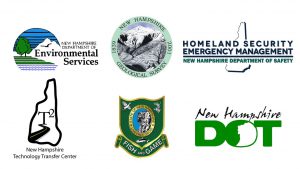The New Hampshire Stream Crossing Initiative is a multi-agency group that collaboratively works to align resources and improve management of stream crossing infrastructure across the state. The Initiative provides the tools needed for stakeholders to make data-driven decisions for targeting investments in projects that support transportation, stream connectivity, fish and wildlife habitat, and flood resilience.

Who We Are
The Initiative is an interagency partnership comprised of representatives from four state agencies and the University of New Hampshire. The Initiative is led by a Steering Committee comprised of experts in the fields of fish biology, geomorphology, transportation infrastructure, asset management, and aquatic ecology. Steering Committee members also represent multiple funding programs that support stream crossing replacements. At the University of New Hampshire, the Technology Transfer Center provides the program with advanced data collection software and online mapping technology. Because stream crossings involve infrastructure, public safety and ecological issues, our integrative team of scientists, transportation managers, and safety specialists, ensure that all interest are being represented in data collection, analysis, and presentation to the public.
What We Do
The primary role of the Initiative is to ensure accurate and consistent survey data is collected and shared publicly. All stream crossing data is collected as a service to promote the safety of our infrastructure and the continuity of New Hampshire’s diverse aquatic ecosystems. The Initiative has three subcommittees that oversee essential aspects of the data collection/ organization, training and outreach, etc. The three subcommittees are represented below.
1) Protocol Development and Training
- Update the field survey protocol to clarify data collection methods for consistency, accuracy, and application in the stream crossing scoring models.
- Organize and conduct the annual stream crossing training, which includes coordinating with partners, creating a training agenda, and conducting site demonstrations.
- Assess the Aquatic Organism Passage (AOP), Geomorphic Compatibility (GC), and Condition (CO) scoring methods and implement necessary modifications to support an accurate representation of stream crossing conditions.
2) Database Management and Quality Control
- Perform quality control review on all stream crossing data that is collected, and update the database to reflect the current stream crossing assessment protocol.
- Maintain the database and perform data cleanup to improve the user experience and ensure a quality display of online public mappers.
- Plan survey locations to coordinate data collection efforts across all agencies and partners to avoid redundancy in efforts and support efficient use of resources to fill in data gaps.
3) Outreach
- Create educational materials such as handouts, brochures, and videos for distribution to stakeholders, municipalities, and conservation agencies.
- Provide outreach through presentations to local entities and at regional conferences to share the initiative’s work, protocol, and data and to do so in a consistent manner.
- Host a reoccurring workshop to update stakeholders about the Initiative, and provide educational opportunities regarding stream crossings at large.
